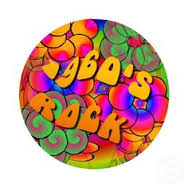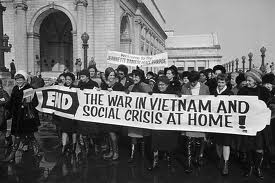Social Activism and the Counterculture
|
 |
Musician Judy Collins performing at anti-Vietnam War rally, Kezar Stadium, San Francisco, 1967 |
|
In the 1960s, Lisa Law and thousands of other Americans were moved by the Vietnam War, racial injustice, fear of nuclear annihilation, and the rampant materialism of capitalist society. Many were inspired by leaders such as John F. Kennedy and Martin Luther King Jr. Small groups staged sit-ins at schools, local lunch counters, and other public facilities. Masses gathered in the nation’s cities to protest what they saw as America’s shortcomings. Many members of the counterculture saw their own lives as ways to express political and social beliefs. Personal appearance, song lyrics, and the arts were some of the methods used to make both individual and communal statements. Though the specifics of the debates were new, arguments for personal freedom, free speech, and political reform go back to the foundations of American society and the arguments of 19th-century social reformers and founders of new communities. |
 |
Artist Liberation Front meeting, San Francisco, 1967. This group of artists presented alternatives to “official” art in the form of street fairs that featured live music, mimes, puppet shows, and participatory painting. |
 |
Victor Maymudes, Bob Dylan’s road manager, with a mandala, a symbol of life, Monterey International Pop Festival, 1967. Maymudes carried this mandala made from burnt doll parts to protest the U.S. dropping of napalm in Vietnam. |
 |
Coretta Scott King, anti-Vietnam War rally, Kezar Stadium, San Francisco, 1967 |
 |
Paul Krassner (center), editor of the underground publication The Realist, and Harvey Kornspan (far right), a member of the Diggers, the Panhandle, San Francisco, 1967. The Diggers were political activists and performers who distributed free food and clothing and staged theatrical events in the streets of San Francisco. |
 |
Tony Price playing the atomic gongs, El Rancho, New Mexico, 1970. Price made musical instruments out of materials salvaged from the U.S. atomic bomb research facility at Los Alamos, New Mexico. |
 |
Black Panthers, anti-Vietnam War rally, Kezar Stadium, San Francisco, 1967. The newly formed Black Panther Party, frustrated with the status quo, called attention to the purportedly disproportionate numbers of black men bearing the burden of combat in the Vietnam War. |
 |
“General Hershey Bar,” San Francisco, 1967. Antiwar demonstrators used street theater and satire to make political commentary. Gen. Lewis B. Hershey headed the Selective Service (Draft Board) in the Vietnam era. |
 |
Communal Living
 |
New Buffalo Commune, Arroyo Hondo, New Mexico, 1967 |
|
Some children of the sixties counterculture dropped out and left the cities for the countryside to experiment with utopian lifestyles. Away from urban problems and suburban sameness, they built new lives structured around shared political goals, organic farming, community service, and the longing to live simply with one’s peers. The Laws lived in several groups of poets, musicians, artists, and idealists. These communities experimented with redefining family structure, the relationship between work and leisure, and the role of their community in the world. Their degrees of success varied, however. Many men and women struggled to balance personal and political freedom with individual responsibilities and commitments, and to develop the farming and building skills needed to sustain the community. |
 |
Caravan, including Lisa and Tom Law’s bus “Silver,” en route to Love-In protest at Los Alamos atomic proving grounds, New Mexico, 1968 |
 |
Horse trainer Tommy Masters teaching Prince to harness, Truchas, New Mexico, 1970 |
 |
Building the communal house at the New Buffalo Commune, Arroyo Hondo, New Mexico, 1968. The Laws traveled to New Mexico to have their first child at a facility that practiced natural childbirth. They helped build the New Buffalo commune and decided to move to New Mexico to live among a group of friends. |
 |
Rick Klein and Steve, Jenna, and Carol Hinton, New Buffalo Commune, 1967. Rick Klein and other benefactors sometimes bought the land and founded communes, enabling members to implement their ideals. |
 |
Ben Marcus and Little Joe Gomez of the Peyote Church, Taos Pueblo, New Mexico, 1967. New Buffalo Commune members interpreted the ways of nearby American Indians to model a new life of self-sufficiency and tribal community. |
 |
Lisa Law writing birth announcements and breast-feeding newborn daughter Dhana Pilar, Embudo, New Mexico, 1967. Lisa Law and Steve Hinton made the cradleboard. Photograph by Tom Law |
 |
Miles Hinton, New Buffalo Commune, 1967 |
 |
Hog Farm Commune members and friends, Spence Hot Springs, Jemez Mountains, New Mexico, 1967 |
 |
Musician, New Buffalo Commune, Arroyo Hondo, New Mexico, 1967 |
 |
Ken Kesey, aboard his bus “Further,” Aspen Meadows, New Mexico, 1969. Author of One Flew Over the Cuckoo’s Nest, Kesey and his troupe, the Merry Pranksters, celebrated both spontaneous street theater to engage a mainstream audience and the use of psychedelic drugs. |
 |
Indian Sikh Yogi Bhajan teaching Kundalini yoga class, summer solstice, Tesuque Reservation, New Mexico, 1969. As part of a spiritual reawakening, some members of the counterculture rejected drug use in favor of mind and spiritual expansion through yoga, meditation, and chanting. |
| We stopped smoking marijuana and started getting high on breathing. Enough of being potheads. Now we could be healthy, happy and holy.
-Lisa Law, 1987 |
 |
Hog Farm leader Wavy Gravy, Llano, New Mexico, 1969. Spontaneity, playfulness, and openness were cherished elements of commune life. |
 |
Commune members Laura and Paul Foster’s wedding at the Hog Farm’s summer solstice celebration, Aspen Meadows, New Mexico, 1968 |
 |
Barry, Patty, and Ever McGuire with Don and Cindy Gallard watching the sunset, New Mexico, 1967. Barry McGuire, formerly of the New Christy Minstrels, recorded the hit protest song “Eve of Destruction.” |
 |
Pilar Law and yoga altar at New Buffalo Commune, 1969 |
| Fifteen of us lived together, one room per family, and a kitchen and a communal room. I can’t say that I enjoyed that kind of living. It always seemed that women ended up doing a lot more chores than the men. The men played music, smoked the herb, chopped wood and repaired vehicles. The lack of privacy was a test.
-Lisa Law, 1987 |
 |
Lisa and Tom Law with children Solar Sat and Dhana Pilar on Law farm, Truchas, New Mexico, 1970. Seeking more independence and privacy, the Laws moved into their own house, farmed, and raised animals. |
 |
Planting first garden on Law farm, Truchas, New Mexico, 1970 |
 |
|
|
 |
Hog Farm members in free kitchen, Woodstock, 1969 |
|
The Woodstock Music and Art Fair made history. It was, depending on one’s point of view, four days of generosity, peace, great music, liberation, and expanding consciousness, or four days of self-indulgence, noise, promiscuity, and illegal drug use. In 1969, Lisa Law and eighty-five experienced commune organizers were asked to assist with the medical tents, security, food services, stage activities, and information booths at a music festival near Woodstock, a little town in upstate New York. Seven months pregnant, with a toddler in hand, Law managed to take photographs of the festival, help run a free kitchen, and film an hour of home movies. She captured images of an event that remains one of the most powerful symbols of the decade. Woodstock enabled thousands of middle-class young people to experience the communal spirit. For the first time, these young people felt empowered by their numbers. Politicians and manufacturers in the music and clothing industries took note of the potential of a growing youth market. |
 |
Hog Farmers arrival at John F. Kennedy Airport en route to the Woodstock Music and Art Fair, Woodstock, New York, 1969. The Laws and others in the counterculture saw music festivals as “purveyors of consciousness and peace.” |
 |
The musical group Quill on stage, Woodstock, 1969 |
 |
Woodstock Music and Art Fair, Woodstock, New York, 1969 |
Afterword
 |
Dennis Hopper, director and co-star of the film Easy Rider, New Mexico, 1970. The New Buffalo Commune served as a model for Hollywood depictions of communal living. |
|
Just as increasing numbers of people were coming to the communes looking for answers, the Laws’ final back-to-the-land experiment at Truchas, New Mexico, was faltering. In 1976, Lisa Law moved to Santa Fe, where she eventually made her living as a photographer. The counterculture movement, greeted with enormous publicity and popular interest, contributed to changes in American culture. A willingness to challenge authority, greater social tolerance, the sense that politics is personal, environmental awareness, and changes in attitudes about gender roles, marriage, and child rearing are legacies of the era. Today Lisa Law lives by the Rio Grande in northern New Mexico in a solar-powered house. Her tepee is pitched beside her organic garden. Law continues to use her camera to document social issues, including efforts to end nuclear arms testing, the struggles of the young and elderly of New Mexico, and issues of Native American sovereignty. |
 |
Janis Joplin and Tommy Masters at Law farm, Truchas, New Mexico, 1970. In 1970, Joplin and fellow musician Jimi Hendrix died of drug and alcohol abuse. |
 |






























